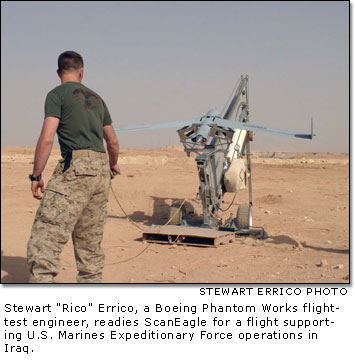| An eye in the sky
ScanEagle provides situational awareness,
clear battlefield picture
BY CHICK RAMEY

 Flying
effortlessly at 1,200 feet over Iraq, ScanEagle's roving "eye"
watches as a group of men disembark from a truck. Two set down their weapons
and begin digging. Flying
effortlessly at 1,200 feet over Iraq, ScanEagle's roving "eye"
watches as a group of men disembark from a truck. Two set down their weapons
and begin digging.
Miles away, at a protected location on the ground, U.S. Marine Corps
tactical commanders watch the action unfold live. ScanEagle's unique reconnaissance
abilities allow them to assess the situation and, if warranted, immediately
send troops to confront the suspected insurgents.
Peggy Holly, Boeing Integrated Defense Advanced Systems ScanEagle program
manager, said that's one example of how the small autonomous unmanned
aerial vehicle can provide real-time situational awareness. Since August
2004, the First and Second Marine Expeditionary Forces have relied heavily
on the 4-foot-long UAV as a forward observer to monitor enemy concentrations
and vehicle and personnel movement.
ScanEagle's "eye" is actually an electro-optical or an infrared
camera, depending on whether it's been tasked with day or night missions.
The UAV's gimbaled camera, with full pan and tilt capabilities, allows
it to easily track both stationary and moving targets.
"ScanEagle has become one of the Marine Corps' most useful tools
for intelligence, surveillance and reconnaissance," Holly said, noting
that ScanEagle has provided more than 6,500 combat flight hours of service
in Iraq.
The Marines aren't the only service making use of ScanEagle. Boeing,
and its partner Insitu, received a contract from the U.S. Navy in April
to support Expeditionary Strike Group missions and help increase oil platform
security in the Persian Gulf. ScanEagle currently is being used to support
Navy high-speed vessels and an afloat forward staging base as well.
Holly added that ScanEagle's operational success can be attributed in
large part to the Boeing and Insitu people embedded with the Marines and
Navy to support launch and recovery activities (see story below).
Meanwhile, back in the United States, Boeing and Insitu are hard at work
incorporating additional capabilities. Said Holly: "I don't think
anyone has yet seen all that ScanEagle can accomplish."
charles.b.ramey@boeing.com
| ScanEagle
'helping save lives' in the field
Boeing and Insitu employees in the United States and abroad are
supporting ScanEagle operations by the U.S. Marine Corps and U.S.
Navy with equal fervor. Those embedded in the field, however, have
additional responsibilities that include daily maintenance, mission
planning/monitoring, and takeoffs and landings from ship or shore.
Since August 2004, small teams from Boeing and Insitu have been
in Iraq working alongside First and Second Marine Expeditionary
Force members. In July, teams also began supporting Navy Expeditionary
Strike Group (ESG) and oil platform security missions.
Employees receive two months of classroom and hands-on flight training
prior to their field assignment. One of those employees, Dennis
DeLong, a Boeing Phantom Works field service representative, was
in Iraq earlier this year flying and maintaining ScanEagle. His
job included everything from takeoff to landing, and then preparing
ScanEagle for its next flight. "The Marines would tell us there
was a certain area they wanted monitored. Our team came in, put
the vehicle together, completed a system check and then launched,"
said DeLong.
Stewart "Rico" Errico, a Boeing Phantom Works flight-test
engineer, recently returned from supporting ScanEagle ESG operations
in the Persian Gulf aboard the USS Cleveland. He also worked with
the Marines in Iraq. Errico said one of the challenges was that
the Cleveland was in a new position daily. "Each day on the
ship we had to quickly get acclimated to our new environs and then
complete additional related tasks prior to launch," he said.
Another challenge was the hostile weather, which included fog and
high winds at sea and extreme temperatures and sandstorms on the
ground.
"It was a rewarding experience to know we were helping save
lives," DeLong said. "I constantly received positive feedback
about how useful ScanEagle's video was to the troops."
"It was a huge draw for me to volunteer for this duty, because
the Marines are my brothers and sisters," said Errico, currently
an inactive Marine Reservist. "I know our team's activities
are helping keep military members safe by providing cutting-edge
support in a critical environment. And that's what it's all about."
—Chick Ramey
|
|

